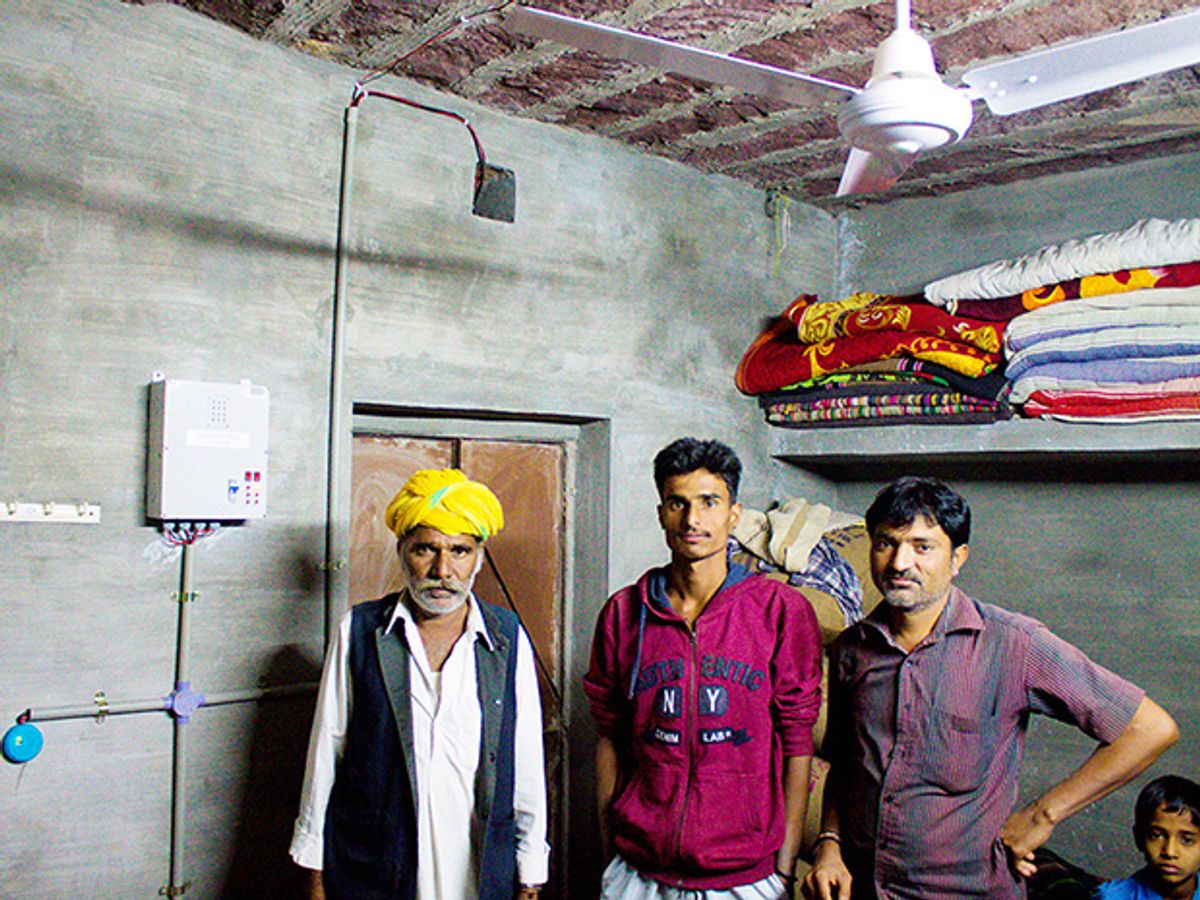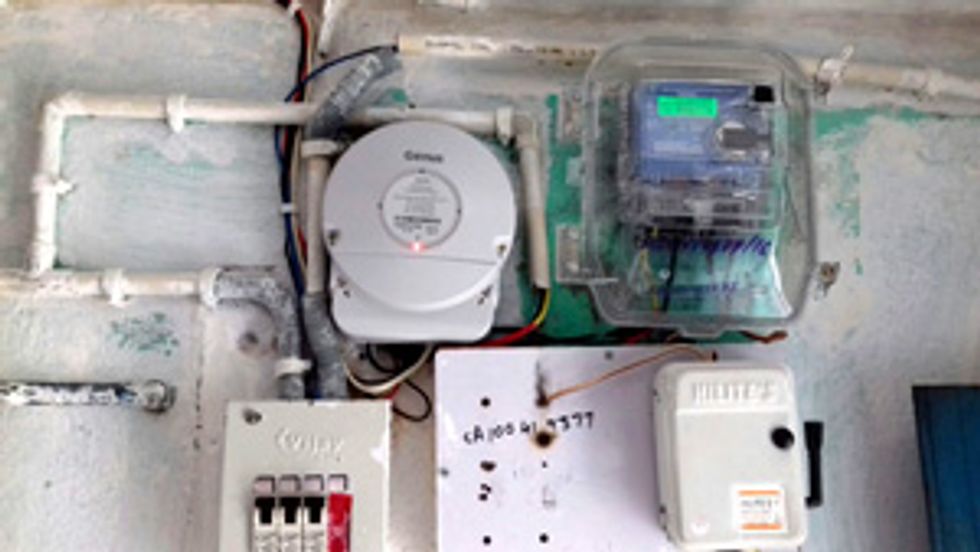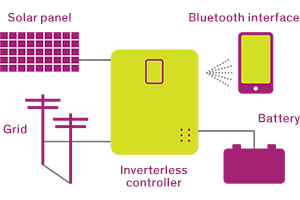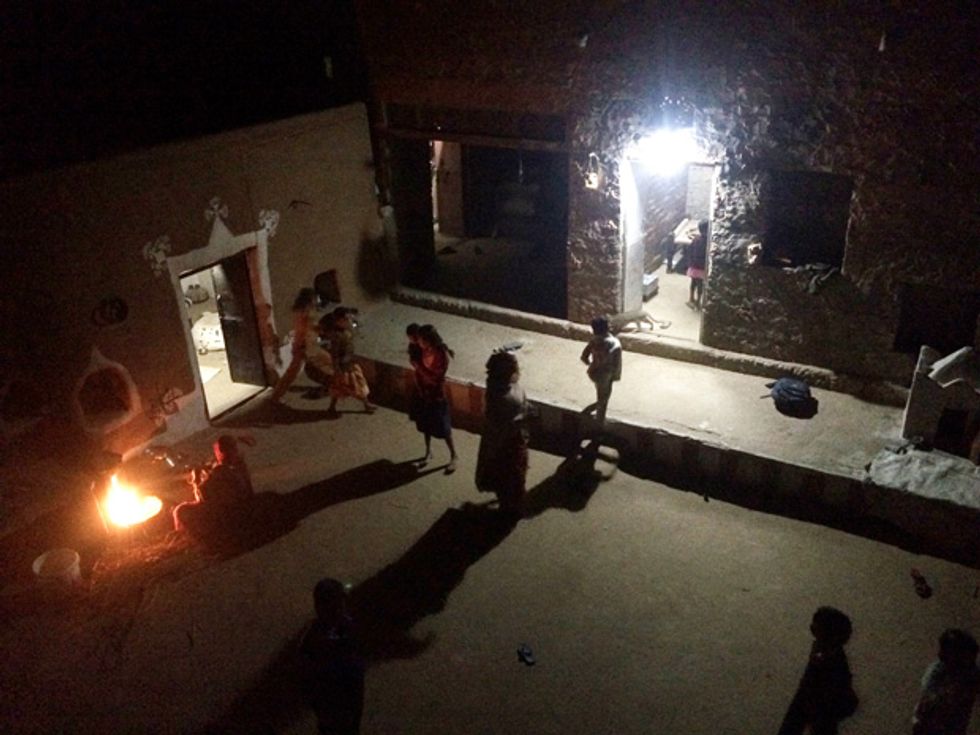Innovative Direct-Current Microgrids to Solve India’s Power Woes
Solar DC microgrids could do for electrification what mobile phones did for telephony

In India, roughly one-fifth of the population has no access to electricity. Solar direct-current microgrids can provide reliable, affordable electricity to areas not served by the traditional grid.









In the industrialized world, the power grid is so reliable that we take it for granted. But in India, where blackouts are a sad fact of daily life, being connected to the grid is no guarantee of reliable electricity. In a 2015 study of villages in six Indian states [PDF], for example, the vast majority reported having fewer than 4 hours of electricity per day; nearly half of the households that reported having a grid connection nevertheless had effectively no electricity. Chief among the reasons they cited were poor reliability, quality, and affordability. In many parts of the country, even middle-income households still find themselves held hostage to frequent power cuts that can last anywhere from a few hours a day to most of the day. Those who can afford to often install diesel generators, an expensive and polluting option.
Then, too, roughly a quarter of a billion Indians, or one-fifth of the population, live without access to any electricity at all, according to the International Energy Agency. For a country where science and technology has otherwise advanced at a breathtaking pace, this sorry state of electrification is a disgrace.
In recent years, the Indian government has invested heavily in electricity generation (including solar- and wind-power plants), state-of-the-art high-voltage transmission lines, and a multitude of household electrification projects. And yet these efforts have made only a modest dent in the problem. A government Web portal that tracks rural electrification efforts shows that in only four of the country’s 29 states do all of the households have access to electricity.
The problem is this: The Indian government has taken a traditional approach to electrification, which focuses on building up generation, transmission, and distribution. But there’s a better way that’s more affordable, more efficient, and much faster and easier to deploy. It can also address all aspects of the electrification problem at once, reducing the gap between demand and supply, bringing down electricity costs, and providing reliable, always available electricity to everyone.
This strategy, developed by my group at the Indian Institute of Technology (IIT) Madras in conjunction with industrial partners, relies on solar-powered direct-current (DC) microgrids. For homes not connected to the grid, a 125-watt microgrid can serve as the sole source of electricity. For connected households, the microgrid acts as a backup power supply to let lighting, fans, TV sets, and cellphone chargers continue operating even during brownouts.
In 2014, we began field-testing our DC microgrid systems in dozens of homes, offices, and dormitories at IIT Madras. The following year, we expanded deployments to about a thousand homes in three cities and multiple villages. Now, with funding from India’s Ministry of Power, we have two large-scale projects under way that will eventually reach more than 100,000 households.
By Western standards, the 125-W load provided by our microgrids is quite modest—an ordinary household vacuum cleaner uses anywhere from 500 to 3,000 W. Indeed, in the typical northern California home, the “idle” load [PDF]—that is, the electricity used by devices that are plugged in but turned off—far exceeds 125 W. And yet, in every place we’ve deployed our system, the recipients have been immensely satisfied because they now have electricity around the clock. They appreciate having lights to prepare a meal or study at night, watching an entire TV program without having it interrupted by a power outage, sleeping through a hot night under the cooling breeze of a fan.
And while India faces a unique challenge in the sheer number of homes that lack electricity, our technology could find uses far beyond India. In fact, we believe every household in the world, whether in Cincinnati or São Paulo, could benefit from having a solar DC microgrid. Here’s why.

Let’s first consider how to shore up the power supply to households that already have a grid connection. As in the rest of the world, India’s main power grid is based on alternating current (AC). Our system, by contrast, relies on DC because PV panels and batteries as well as consumer electronics, LED lighting, and a growing range of appliances all work with direct current, and we thus avoid the losses that come with converting back and forth between AC and DC. Each conversion incurs a power loss of 5 to 20 percent, so for the sake of efficiency, you want to minimize the conversions.
We start by running an additional power line in the home. It is a 48-volt DC line and provides about 10 percent of the typical household load. LED lightbulbs, electronics, or small appliances that have been designed to run on DC can be fed directly by this line. We also replace the traditional electricity meter with what we call an uninterrupted direct-current (UDC) power meter, which has the same control and communications capabilities of a smart meter, along with an AC-to-DC converter for converting a portion of the incoming AC to DC.

Now let’s say that demand on the grid is peaking, and generation can’t keep up. The typical practice in India is for the grid operator to cut power completely in some areas until the careful balance of supply and demand has been restored. In areas where our UDC system has been deployed, the grid operator instead institutes a brownout, cutting power by 90 percent. The remaining 10 percent may not sound like much power, but bolstered with current from some storage batteries (more on them below), it’s actually enough for the household to keep the lights on and perhaps a few DC appliances, too. At the start of the brownout, the local substation signals each UDC meter, which instantly cuts off the home’s main AC power line but maintains the DC power. When the brownout is over, the substation signals the UDC meter again, and it restores regular AC power in the home.
Since 2015, we’ve been collaborating with the Hyderabad-based solar power company Cygni Energy to roll out UDC systems in the city of Sasaram, in the northeastern state of Bihar. There, up to 100,000 households will soon receive DC microgrids. Although these homes are connected to the existing AC power grid, the reliability is poor, and residents are desperate for an alternative. Bihar has the largest deficit between peak demand and supply of any Indian state and the lowest per capita electricity consumption. Eventually, Sasaram could become the first city in the world to have a DC power line installed in every home.
To supplement the power coming from the main grid, each UDC household can also install a 125- to 500-W photovoltaic panel, which connects through the UDC meter to a low-cost but high-performance lead-acid battery developed by Amara Raja Batteries. The battery supplies electricity at night and during brownouts.
Unlike the vast majority of residential solar installations being deployed these days, ours is an entirely DC system. We thus avoid the inefficiency of converting the panel’s direct current to AC for synchronizing to the main grid, the conversion back to DC to charge the battery, and a third conversion from DC back to AC when the battery is discharged.
Taken together, the DC line from the main grid and the solar microgrid are enough to power five fans, eight LED lights, two small flat-screen TVs, several cellphone and tablet chargers, and a laptop. These are all DC-compatible devices, of course, and use much less power than do AC appliances. The fans use brushless DC motors; where an AC fan might consume 72 W, a DC fan with comparable airflow will use just 30 W. Similar brushless DC motors could one day be used in refrigerators, air conditioners, and washing machines. As for LED lighting, LCD TVs, computers, and the like, they already run on DC; to plug them into a traditional AC outlet, manufacturers add on an AC-to-DC converter. So configuring them to operate on a DC line mostly involves replacing the AC-to-DC converter with a much more efficient DC-to-DC controller.
By using DC-compatible lights and devices instead of their AC alternatives, homeowners can dramatically reduce their electricity usage and thus their monthly bills. We ran simulations to compare the costs of a solar-powered AC microgrid and a solar DC microgrid. We calculated the consumption for a small home equipped with two LED tube lights, two LED lightbulbs, two fans, a mobile phone, and a 24-inch LED TV. With an AC solar microgrid running AC lights and appliances, the home used 3.3 kilowatt-hours a day, at a cost of 16.3 rupees (24 U.S. cents). With a DC microgrid, the usage was just 1.2 kWh at 6.5 rupees (9.5 U.S. cents) because of the higher efficiency of the DC appliances and the lack of conversion losses.
We then looked at how the microgrids would perform during a load-shedding brownout that occurred every day and lasted 4 hours—a common pattern in many parts of India. In such a situation, the microgrid’s battery would be discharged and then later recharged. As noted above, the solar-powered AC microgrid would see significant losses associated with converting from AC to DC and back again. Factoring in the load shedding would raise the daily cost for the AC microgrid to 28.9 rupees (42 U.S. cents), while the DC grid’s cost would go up only slightly, to 7.3 rupees (11 U.S. cents). Over a month’s time, the potential savings from the DC system could amount to more than 400 rupees ($5.90). That may not sound like a lot of money to an affluent resident of a developed country. But in many parts of India, it is. It could mean the difference between keeping the lights on or sitting in the dark, between having a working fan or sweating in one’s bed.
Solar DC microgrids are also starting to have an impact in Indian villages that have never had grid-provided electricity. Our largest installation to date involves 71 villages in the western state of Rajasthan, where we have been working with the utility company Jodhpur Vidyut Vitran Nigam to electrify some 4,000 homes for the Ministry of Power. [For another example of electrification of a remote Indian village in the Himalayas, see "Lights for the Enlightened," IEEE Spectrum, December 2016.]

Before the project began, the villagers basically lived in darkness at night. Rajasthan actually has enough power to meet the needs of its entire population; the problem is delivering that power to every household.
Our first village was Bhom Ji ka Gaon, a community of 120 households that lies among the mighty sand dunes of Rajasthan. The village is 90 kilometers from the nearest town and 300 km from the nearest city, Jodhpur. The homes are spread out over an area of about 10 square kilometers. With no paved roads, crossing the sand dunes is best done by camel cart, tractor, or four-wheel drive. The people collect rainwater to irrigate their crops and raise their livestock. Most residents don’t venture out of the village except when they need to grind wheat or millet.
For the conventional power grid to reach this remote site would require building substations and power lines—a difficult and economically unfeasible proposition given the uneven terrain, long distances, and occasional severe sandstorms. What’s more, the chances of recovering such an investment would be slim at best: Although the villagers are self-sufficient, they don’t earn much money and so wouldn’t be able to buy a lot of electricity even if it were available.
What Rajasthan does have are clear skies and abundant sunlight for most of the year. So it’s ideal for solar power and indeed has already attracted several large PV power plants, most notably a proposed 4,000-MW facility near Sambhar Lake that would be the world’s largest. But these plants have many of the same problems of a traditional grid connection: They require transmission and distribution infrastructure to channel the captured power to nearby villages, and they suffer conversion losses when the DC power generated by the solar panels is converted to AC power.
In our deployments in Rajasthan, each home is given a 125-W solar panel, a specially designed 1-kWh lead-acid battery with an expected life span of 1,600 cycles (compared to about 800 cycles for a normal battery), and an inverterless controller box. Each house also gets a complement of devices: a full-size DC fan, a dimmable LED tube light, a remote for controlling the fan and tube light, an LED lightbulb, and a cellphone charger. The homeowner can add extra lights or a TV set, as long as the overall load doesn’t exceed 125 W. The entire system is being manufactured and installed for a fraction of the cost of traditional grid electrification.
We’ve also done installations outside of Rajasthan in which groups of two to four houses share a single 500-W microgrid and one installation in which about 30 houses now share a 7,500-W microgrid. With these larger networks, the amount of electricity allotted to each household can be remotely varied, to accommodate different-size households, via a wireless connection to the UDC meter in each home. The shared equipment reduces the installation and operating costs for each household.

For villages like Bhom Ji ka Gaon, conventional electrification is many years away, at best. In the meantime, DC appliances will keep getting better and a wider range of products will come to market, including evaporative coolers, small DC refrigerators, and solar stoves. At the same time, solar panels, batteries, and other microgrid components will continue to become cheaper and more efficient. In the end, the villagers may find that their off-grid systems provide all that they need.
India’s power problems are deep and pervasive. And yet the country’s experience with telephony offers a glimmer of hope. Until the mid-1990s, not even 5 percent of Indian homes had a phone, and in many places you’d wait for years just to get a landline installed. The main problem was the cost of copper cable, which made such connections prohibitively expensive for most people.
Then came cellphones and the rapid expansion of the cellular network. Today, nearly every adult in India has a mobile phone, which provides so much more functionality than a landline phone ever could. And the number and range of mobile services continue to grow all the time.
So too could India’s electrification follow an unconventional, disruptive path. We hope that solar DC microgrids paired with UDC meters evolve like India’s cellular network, leapfrogging over traditional infrastructure. Introducing DC lines into the home will naturally boost the market for DC appliances, which in turn will begin to edge out more power-hungry AC alternatives. Over time, those appliances as well as the microgrid equipment will become more affordable, even for rural villagers with little income. And as households consume far less energy and generate that energy right where it’s used, their utility bills will drop. As homes become less dependent on the traditional grid, they’ll be less affected by power cuts; eventually, such outages will disappear, as gaps between supply and demand go away.
We know that this technology can transform lives. We’ve seen what even a modest level of access to electricity can do, and we’ve heard many moving and inspiring stories from villagers who now enjoy comforts, conveniences, and security that they never thought they’d have. This is one of those rare moments when technological breakthroughs can come together to make it possible to do good on a massive scale. For the 1.2 billion people in this world who still live without electricity, it cannot happen soon enough.
This article appears in the February 2017 print issue as “The People’s Grid.”
About the Author
Ashok Jhunjhunwala is an electrical engineering professor at the Indian Institute of Technology Madras, in Chennai, and founder of the Telecommunications and Computer Networks group (TeNeT), which has worked closely with industry to develop products for the Indian telecom, banking, and power industries. IEEE Spectrum featured Jhunjhunwala in its Engineering Heroes special report in 2015.